How to Create a Backup Power Kit at Home Without Installing a Generator
Laundry has a way of creeping up on you. One day the hamper’s half-full, and before you know it, there’s a mountain of clothes threatening to spill over. But it’s not just the volume that makes laundry so draining — it’s the number of tiny decisions and repetitive steps involved. Sorting colors, digging out tangled items, hoping your delicate top survives the spin cycle, folding clothes that somehow never fold right, and trying to figure out where to hang wet laundry when you’re short on space. It adds up. And it wears you out.
The task itself isn’t that hard — it’s the disorganization and little annoyances that make it feel like a chore you never really finish. Clothes get wrinkled because you don’t fold them right away. Socks vanish. Delicate fabrics get ruined. And if you live in a small space, even figuring out where to dry your clothes can turn into a puzzle.
But laundry doesn’t have to feel like a constant frustration. A few small changes — both in how you organize the process and the tools you use — can make a huge difference. No need for expensive appliances or complicated systems. Just some smarter ways to sort, wash, fold, and dry. When you cut out the friction points, laundry becomes something you get through quickly and efficiently, instead of something you dread and avoid.
In this article, we’ll walk through practical ways to simplify your laundry routine. From how you separate clothes to how you fold them, and what tools actually help (and don’t just take up space), this guide focuses on what really works — not what sounds good in theory. Whether you’re dealing with a cramped apartment or a full household’s worth of laundry, these tips are meant to reduce stress, save time, and maybe even help you feel a bit more in control of your week.
So if you’re tired of laundry day feeling like a battle, keep reading. There’s a better way to handle it — and it starts with making a few smart adjustments.
Sort Smarter, Not Harder
Sorting laundry may seem like a basic step — just separate the whites from the colors, right? But when it’s done right (and early), it can actually make your entire laundry process faster, more efficient, and far less stressful. Most of the problems people face during laundry — color bleeding, worn-out fabrics, shrunken shirts — often trace back to poor or rushed sorting. And the annoying part? These issues are completely preventable.
The first mistake many people make is leaving sorting until the very last minute, when laundry has already piled up. That’s when it turns into a chaotic guessing game: “Is this dark blue or black? Can I mix this towel with my gym clothes? Where’s the other sock?” You waste time making decisions that could’ve been avoided — and often, you just throw it all in together out of frustration.
The fix is simple: set up a pre-sorting system so everything gets divided as it’s tossed in. That means no more scrambling when it’s time to wash. Ideally, you want at least two compartments — one for lights, one for darks. If you have space, add a third for towels or delicates. For households with kids or shared spaces, a fourth section for heavily soiled clothes (like muddy pants or gym wear) can also be helpful.
This system saves more than just time. It protects your clothes, too. Washing delicate items with rough fabrics like jeans or towels can cause snags or premature wear. Mixing bright colors with whites risks bleeding — especially in warm water. Even separating synthetics from natural fibers (like polyester from cotton) can help with drying time and fabric longevity.
And here’s another unexpected benefit: sorting helps you notice your laundry patterns. You might realize you’re going through too many dark t-shirts, or that towels are piling up faster than anything else. That kind of insight can help you manage laundry loads more strategically — maybe you’ll do a quick mid-week towel wash instead of letting it all pile up.
If you’re living in a small space or sharing laundry areas, compact sorters or bags that hang inside a closet door can still give you that separation without taking up precious room. The key is keeping your system visible and easy to use — the fewer steps between taking off your clothes and placing them in the right bin, the better the chances you’ll stick to it without thinking.
Once you’ve built sorting into your daily routine, laundry day becomes far less overwhelming. No more dumping a mountain of mixed clothes on the floor just to get started. Everything’s already separated and ready to go. You just grab a load and start the wash — no drama, no sorting session, no wasted time.
Think of sorting not as a chore, but as a small setup step that makes the rest of the process smoother. It’s like laying out ingredients before cooking or packing your bag the night before work. A little upfront effort, and suddenly things feel a lot easier.
SimpleHouseware Heavy-Duty 3-Bag Laundry Sorter
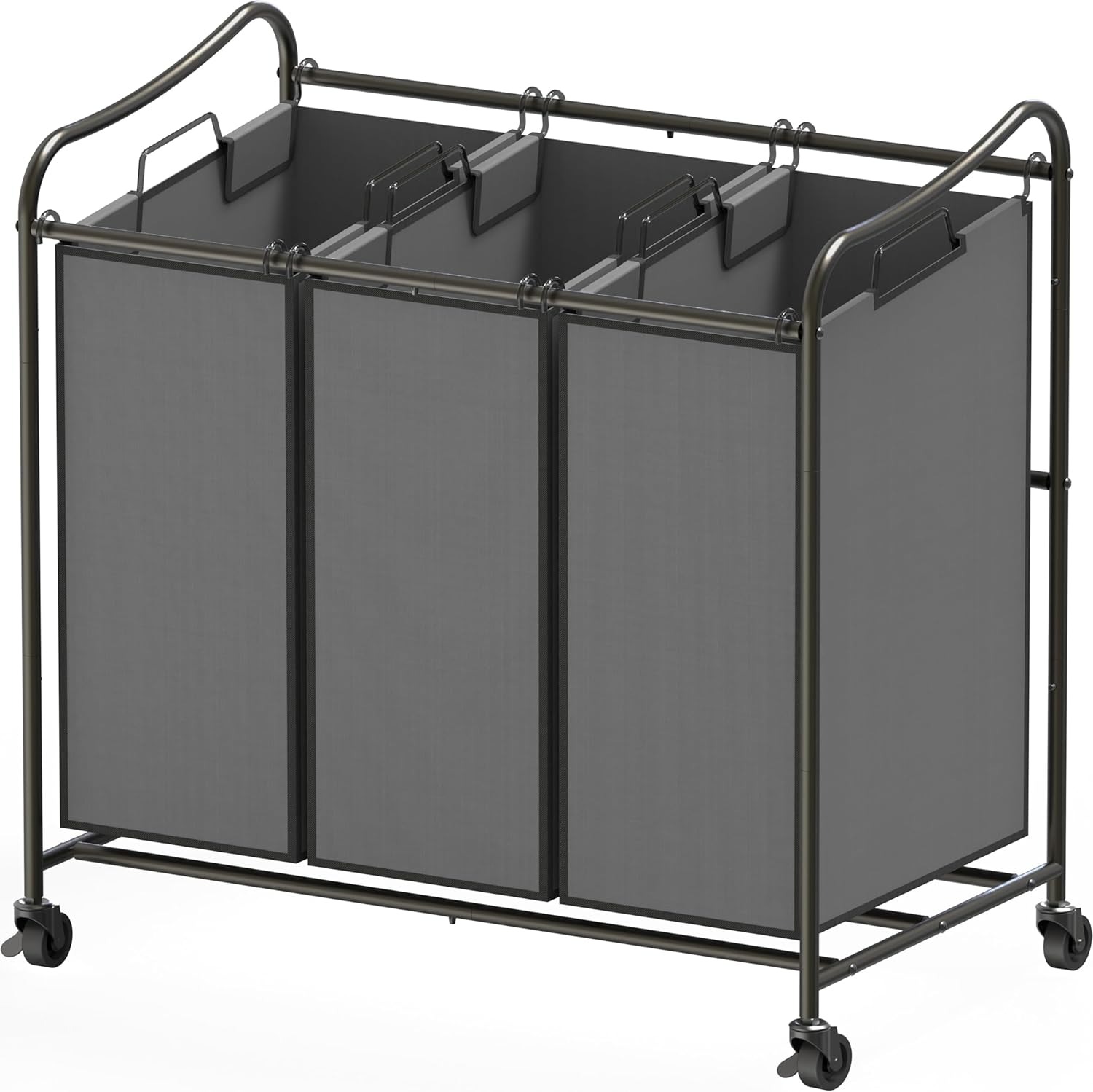
This is a great option if you’re dealing with regular laundry loads and want to keep things running smoothly. The frame is made from steel, which gives it a solid feel, and it comes with three removable canvas bags that make sorting automatic. You can toss lights in one, darks in another, and maybe use the third for towels or workout gear — all without thinking twice.
What really makes this sorter stand out is the ease of movement. It has smooth-rolling wheels, so you can wheel it from the bedroom to the laundry room without dragging or lifting. The brakes lock the frame in place, so it stays put once you’ve got it where you need it.
Each bag is deep enough to hold a full load and comes off easily, so instead of juggling armfuls of laundry, you can just grab a bag and go. If your laundry tends to pile up or you live with others and want a more structured routine, this kind of setup saves time and reduces mess.
Lifewit 3-Section Slim Laundry Hamper with Lid
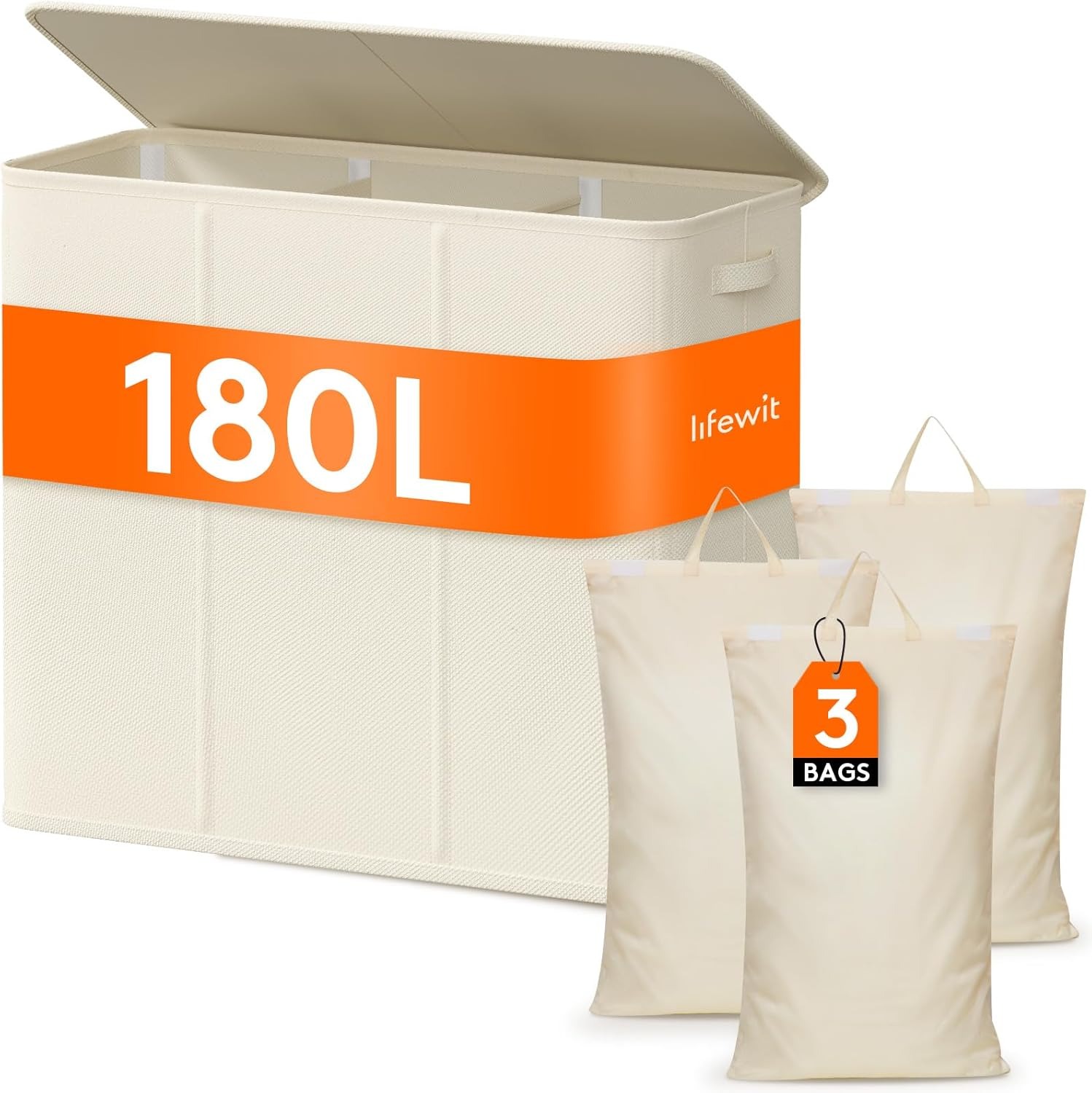
For those who don’t have a lot of space to spare, this slim hamper is surprisingly efficient. It has three internal compartments built right into a single unit — perfect for keeping clothes sorted throughout the week without needing extra bins or baskets.
Its narrow design fits into tight spots like between furniture, inside a closet, or against a wall, and the fabric is sturdy enough to hold its shape even when it’s full. The lid helps keep things tidy and contained, which makes a difference if the hamper is out in the open or you’re sharing a room.
Although it’s not built for hauling super-heavy loads like blankets or big towels, it handles everyday clothing just fine. The labeled sections take the guesswork out of sorting, and the built-in handles make it easy to carry when it’s time to wash.
This one’s a practical pick for anyone looking for a clean, low-profile solution that doesn’t sacrifice function for space.
Wash with Confidence
Once your laundry is sorted, the next step — actually washing it — can still feel like a gamble. Will that delicate blouse survive the spin cycle? Are those socks going to vanish again? Why did the dark shirt suddenly bleed onto everything else? Even with modern machines, washing clothes can go wrong fast if you’re not prepared.
The truth is, most laundry mishaps aren’t caused by the machine. They happen because clothes aren’t properly protected, or because small items get tangled, stretched, or lost in the process. And once damage is done — a snagged bra strap, a shrunk sweater, or a missing sock — there’s usually no going back.
That’s why it’s worth setting yourself up for success before you even press start.
One of the biggest game changers is understanding your fabrics and how they behave in the wash. Delicates like lace, silk, or activewear fabrics don’t belong in the same load as heavy jeans or rough towels. When washed together, the friction can cause pilling, tearing, or shape loss. Stretchy fabrics, especially, need gentle care to avoid damage — and putting them in a regular cycle is often what shortens their lifespan.
Another area where things often go wrong is with small items: socks, underwear, baby clothes, washable masks. These tend to get lost in the machine or wrapped up in larger items like bedsheets or pant legs. It’s not your washer’s fault — it’s just physics. When these tiny things are loose in the drum, they get caught, tangled, and sometimes never come out again.
Color bleeding is another headache, especially when new clothes haven’t been washed before. One red T-shirt can turn an entire load of whites into a pink-tinted regret. And yes, dark jeans can still bleed even after a few washes — it depends on the dye and the water temperature.
All of these issues are preventable with just a few extra steps. Using cold water for mixed or colored loads can minimize dye transfer. Separating delicates or small items into protective containers can keep them from getting damaged or lost. And reading those care labels — even quickly — can make the difference between clothes that last and clothes that fade, shrink, or fall apart.
Washing clothes the right way isn’t about being overly cautious — it’s about protecting your time, your money, and the clothes you already own. Because no one wants to replace a favorite shirt or hunt through laundry baskets looking for that one missing sock.
It might take an extra minute to prep a load properly, but the payoff is worth it. Cleaner clothes, fewer losses, and a much more predictable outcome. That’s what washing with confidence looks like.
BAGAIL Mesh Laundry Bags for Delicates
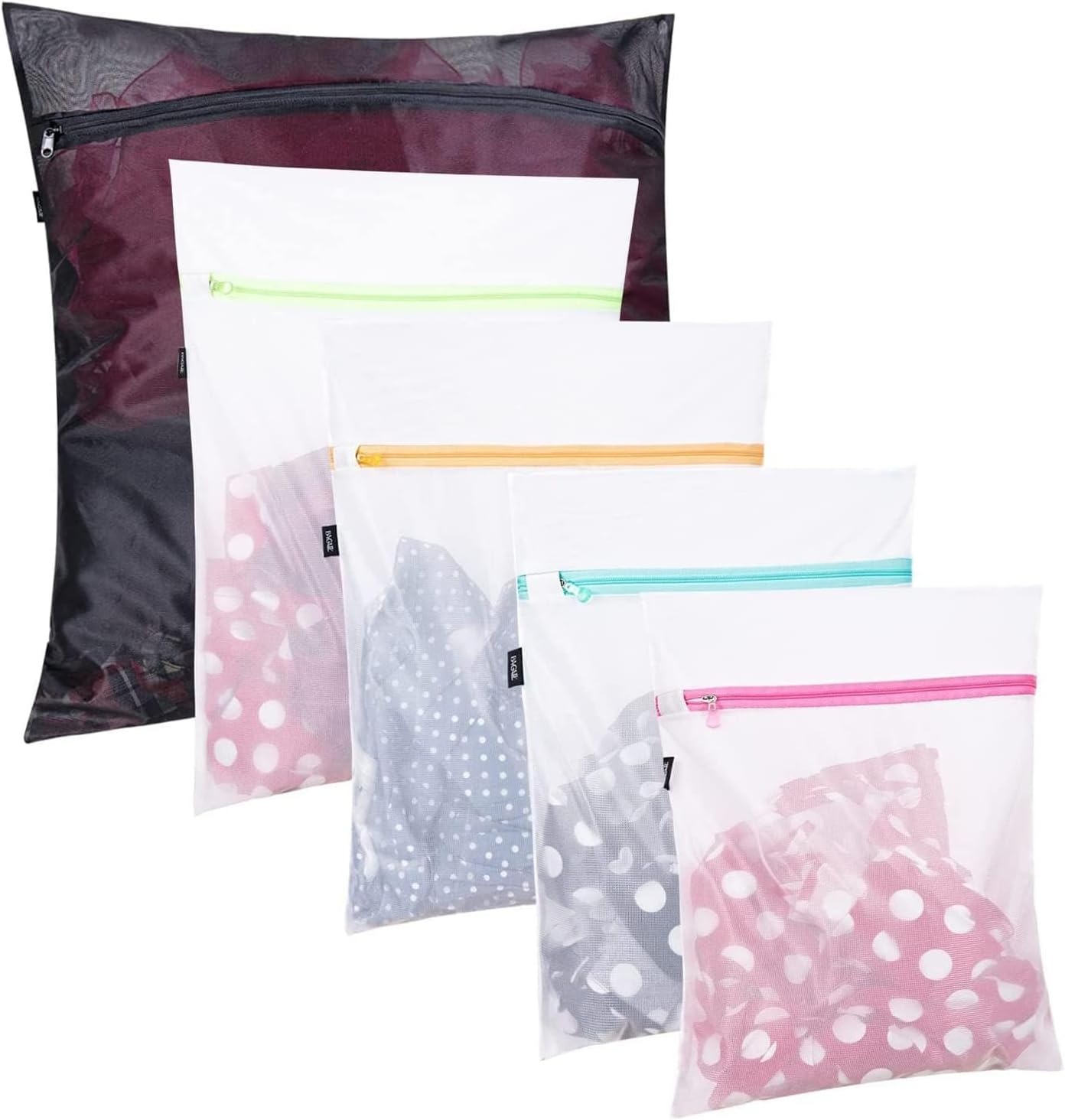
This set of mesh laundry bags is a small investment that can make a big difference in how your clothes hold up over time. It includes five different sizes, ranging from small (ideal for socks and underwear) to extra-large (big enough for sweaters or athletic gear). Each bag is made from a fine, durable mesh that allows water and detergent to flow through freely, while still protecting fabrics from friction, stretching, or getting tangled in the wash.
One key advantage here is how these bags keep similar items grouped. No more socks getting lost or lace bras snagging on zippers or buttons. They also reduce pilling and help maintain the shape of delicate pieces that would otherwise be beaten up during a full wash cycle.
The zippers are tucked into a protective cover so they don’t damage other clothes, and the stitching holds up well — even after dozens of cycles. Once you start using these, it’s hard to go back. You’ll probably wonder how you ever washed delicates without them.
These bags are especially useful if you own activewear, lingerie, kids’ clothes, or any items that tend to shrink, stretch, or disappear.
TENRAI Zippered Sock and Underwear Mesh Bag
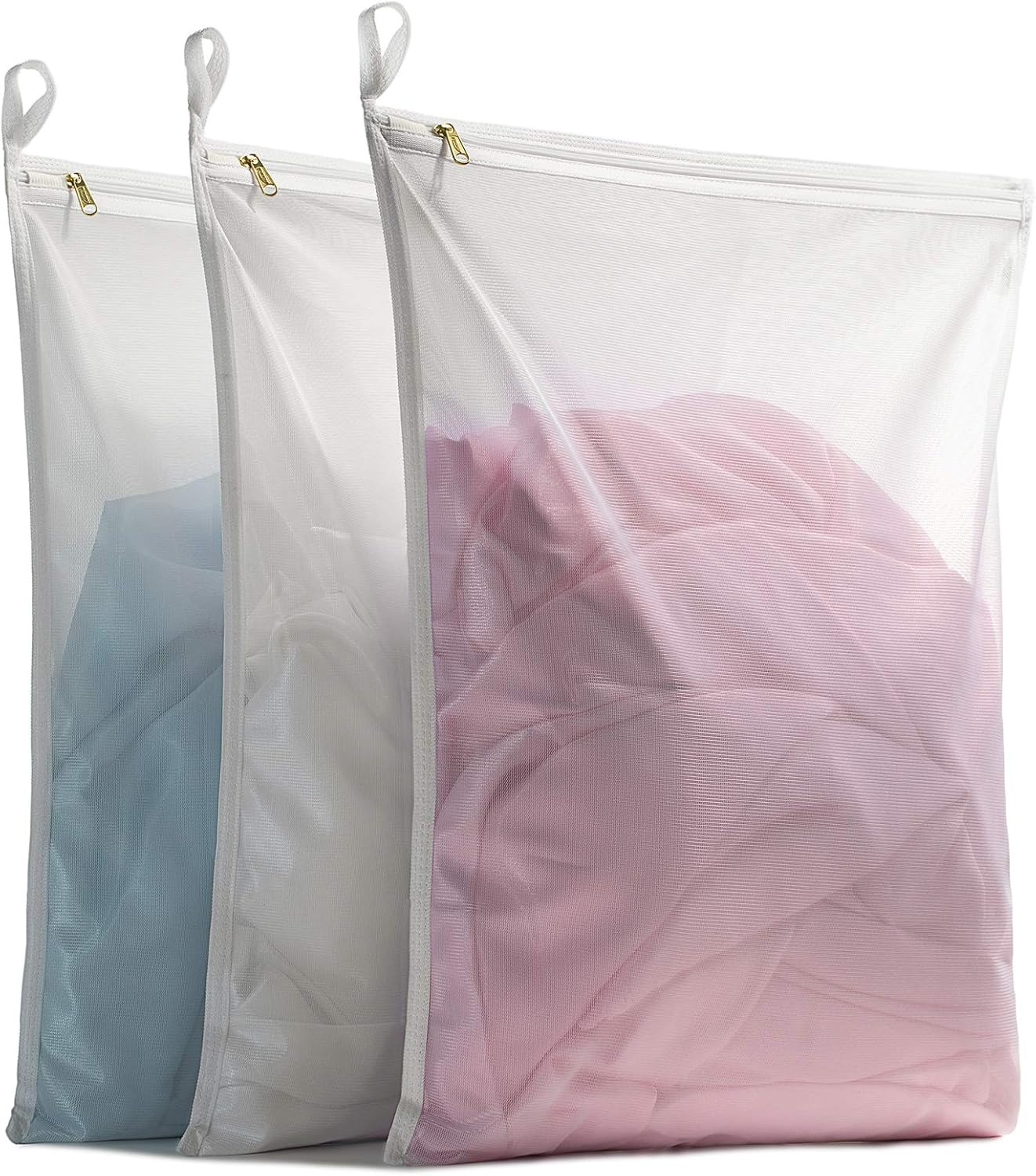
If you’ve ever lost a sock (or five), this set of fine-weave mesh bags is worth a look. Unlike many standard mesh bags, these are specifically designed for smaller items like socks, underwear, baby clothes, and washable face masks — the kind of things that are most likely to vanish in the wash.
The material is ultra-fine but durable, so it won’t trap lint or tear easily. It’s also soft enough that it doesn’t rough up delicate fabrics. The zippers are rustproof and smooth, and each one tucks into a fabric flap so they don’t catch on other clothes. The size is perfect for grouping smaller items together, which not only prevents loss but also makes sorting and folding faster once everything is dry.
They’re also helpful if you live in a shared home or use a laundromat — you can toss everything in without worrying about separating your stuff later. It’s a simple way to add peace of mind to laundry day, especially if you’re tired of losing time (and patience) looking for missing items.
Folding Doesn’t Have to Suck
Let’s be honest — folding is where most of us lose steam. The clothes are clean, the hard part’s technically over… but now you’ve got a mountain of shirts, socks, and jeans that need to be sorted, folded, and put away. It’s the part people tend to procrastinate the most, and it’s also where clutter begins to creep back in.
The good news is, folding doesn’t have to be so frustrating — if you remove the guesswork and repetition. Most of the pain comes from two things: not having a clear system and not having a consistent technique. Every item feels like a new puzzle: Which way do I fold this shirt again? Why does this pile keep falling over? Do I even have space to fit all this?
Creating a simple, repeatable process makes folding faster, neater, and way less stressful. When you fold clothes the same way every time, you don’t just save time — you also save space. Neatly folded clothes take up less room in drawers and shelves, stay wrinkle-free longer, and are easier to find later. You’re not just folding for tidiness — you’re folding for function.
This is especially true for shirts, pants, and kids’ clothes — things that tend to end up wrinkled or thrown back into piles if they’re not stacked properly. The less effort it takes to fold something well, the more likely you are to actually do it, instead of letting clean clothes sit in a basket for days.
Another underestimated factor is workspace. If you’re folding laundry on a wobbly chair or in a cluttered room, it’s going to feel like a chore. Having a clean, flat surface — even just a table or the top of the dryer — makes folding quicker and less annoying. You’re not fighting the space while trying to do the task.
And if you’re managing laundry for multiple people, things get even more chaotic without a plan. That’s when you end up folding five similar T-shirts and not remembering whose is whose. In those cases, separating and folding each person’s load individually can help avoid mix-ups and save sorting time.
Finally, the idea that folding needs to be perfect? Not true. You don’t need department-store-level presentation. You just need clothes that stack neatly, fit in their drawers, and are easy to grab without making a mess. If you’re consistently frustrated with how long folding takes or how quickly things unravel, that’s a sign your current system isn’t working — not that folding is inherently terrible.
With just a few small tweaks — and the right tools — folding can become less of a drag and more of a fast, automatic part of your routine. Not glamorous, but definitely doable.
BoxLegend V2 Shirt Folding Board
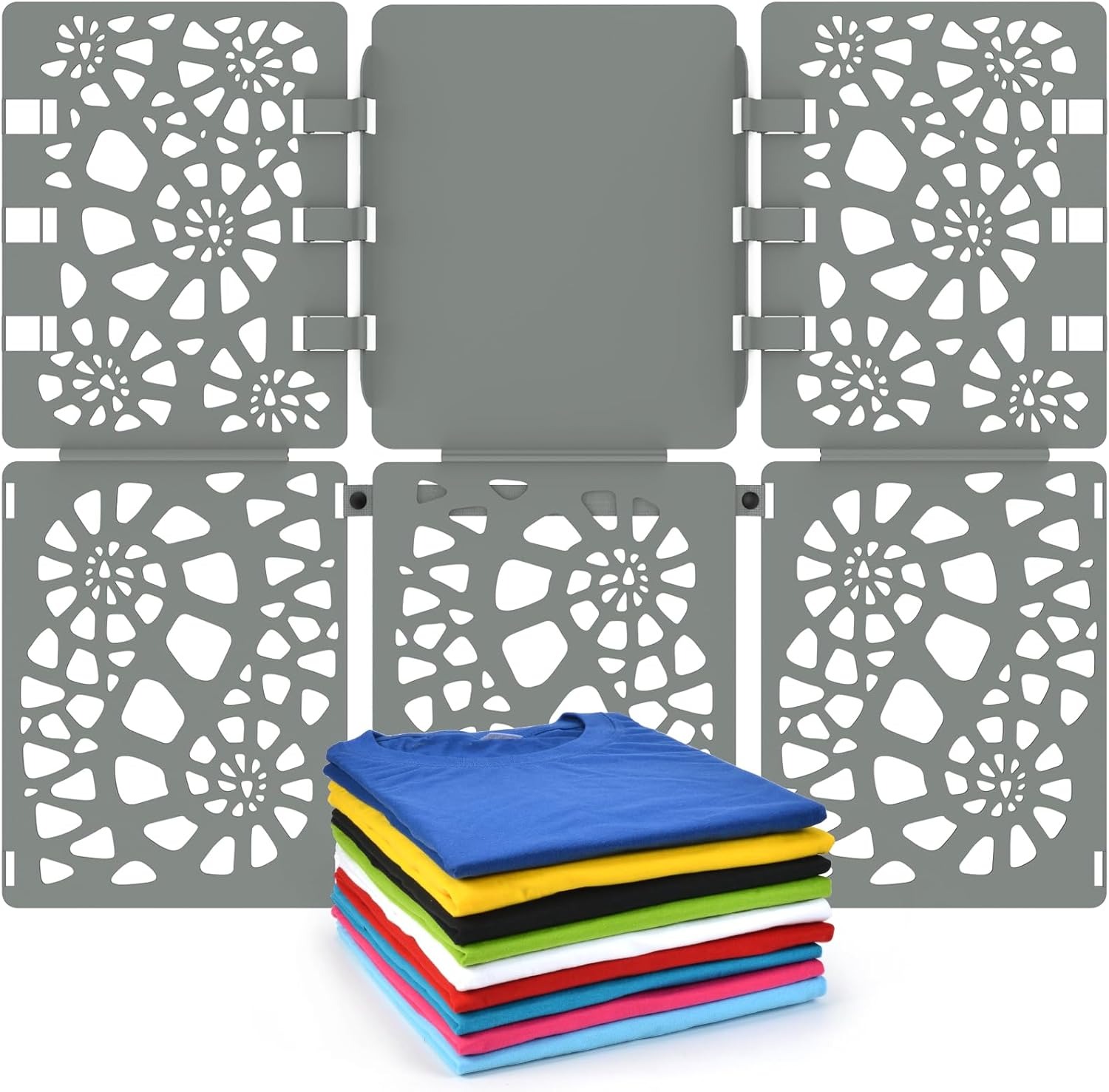
This folding board is a simple but surprisingly effective tool for anyone who wants neatly folded clothes without wasting time. The BoxLegend V2 is made of lightweight, flexible plastic panels that fold out in a few quick movements — you just place the shirt in position, flip the sides over in order, and you’re done. It creates a uniform fold every time, which means your stacks stay flat and organized, whether you’re using drawers, shelves, or luggage.
This tool is especially helpful for people who feel like folding is slow or inconsistent. T-shirts, polos, sweaters — they all come out the same shape and size, which makes putting them away faster and prevents piles from collapsing. If you live in a small space or share storage with someone else, that consistency really helps maximize available room.
The board itself folds up compactly when you’re not using it and can be stashed in a drawer or beside your laundry area. It doesn’t require any instructions once you’ve used it a few times — just muscle memory and quick flips.
Great for adults, kids’ clothes, and even some types of pants or light jackets.
GOBETTER Laundry Folding Board
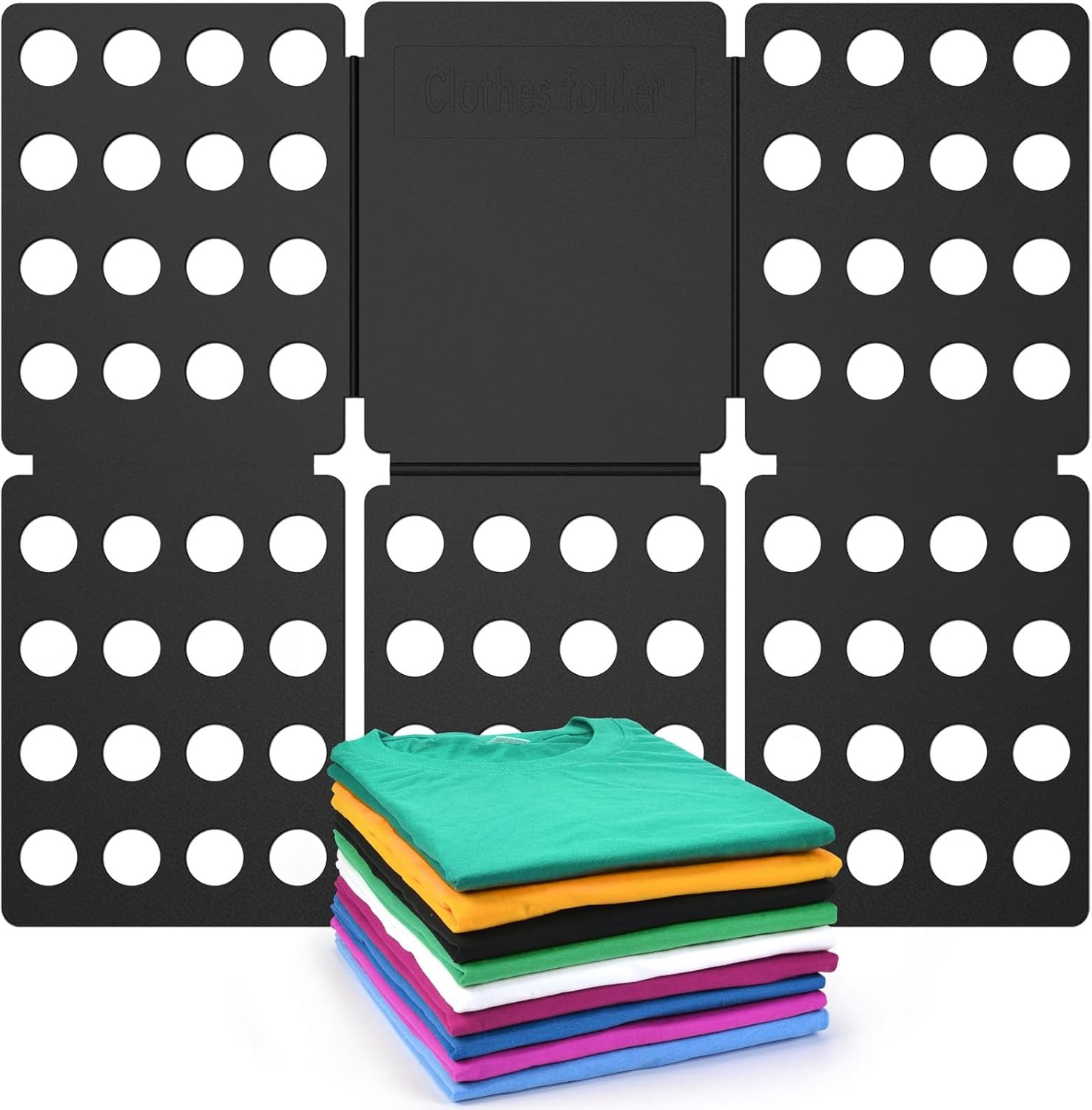
If you’re folding a variety of clothing sizes — adult, teen, child — this adjustable folding board might make life easier. The GOBETTER Folding Board has similar functionality to other folding boards but includes adjustable panels, allowing you to tweak the folding size depending on the garment.
It’s especially useful for families with kids or anyone trying to organize clothing by drawer size or travel bags. You can fold small T-shirts, larger sweaters, and even thin pants all using the same tool. The folds come out consistent and flat, which helps eliminate bulky or awkward stacks that slide around or take up too much space.
The material is sturdy but lightweight, and it’s easy to clean with a quick wipe-down. Once you get into the rhythm, you can knock out an entire laundry basket in a few minutes — and most importantly, it all fits where it’s supposed to go afterward.
While it might seem unnecessary at first, this tool is great for turning “I’ll fold it later” into “I’m done in five minutes.”
Air Drying Without Chaos
Air drying is one of the simplest ways to protect your clothes, save on energy bills, and extend the life of fabrics — but let’s be real: it can quickly turn into a mess. Wet clothes draped over chairs, socks hanging from door handles, jeans stiffly drying on the balcony railing… It works, kind of, but it’s far from ideal.
The biggest problem with air drying isn’t the concept — it’s the lack of space and structure. Most homes or apartments aren’t designed with air drying in mind, so people end up improvising. And while that might work for a shirt or two, it becomes a logistical headache once you’re trying to dry a full load.
Without a proper system, air drying takes up way too much room. Wet clothes hanging everywhere feel chaotic, make the space hard to use, and can even lead to problems like mildew if airflow is poor. That’s not exactly the fresh laundry vibe anyone’s going for.
But when done right, air drying is incredibly useful. It keeps delicate fabrics from shrinking, helps reduce wrinkles, and avoids the wear-and-tear of tumbling in the dryer. It’s especially helpful for items like athletic wear, lingerie, wool, or anything with elastic — materials that degrade faster when exposed to high heat.
To make air drying manageable, the goal is to create a designated space that’s efficient, compact, and easy to access. That doesn’t mean you need a laundry room or a fancy setup — just something that gives structure and airflow without taking over your entire living area.
There are a few key things to think about:
Vertical space matters more than horizontal. Drying racks that fold out or hang from doors can give you usable drying area without eating up square footage.
Air circulation is essential. Wet clothes need breathing room. Crowding them onto a rack will slow down drying time and can make clothes smell musty.
Weight balance matters, too. Heavy items like jeans or towels can tip lightweight racks if they’re not supported properly — especially if everything’s drying on one side.
A good drying setup should make it easy to hang multiple items, allow air to flow freely, and fold away when you’re done. Once you have a system in place, it becomes second nature — not something you dread or avoid.
And in many cases, air drying just works better. You preserve color, fabric shape, and avoid accidental shrinkage. You also get that fresh-air feel if you’re drying near a window or outside. The trick is avoiding the visual clutter and keeping the drying process contained.
With the right tools, you can turn air drying from a scattered mess into a tidy, streamlined part of your routine — one that’s good for your clothes and your space.
Honey-Can-Do Over-The-Door Drying Rack
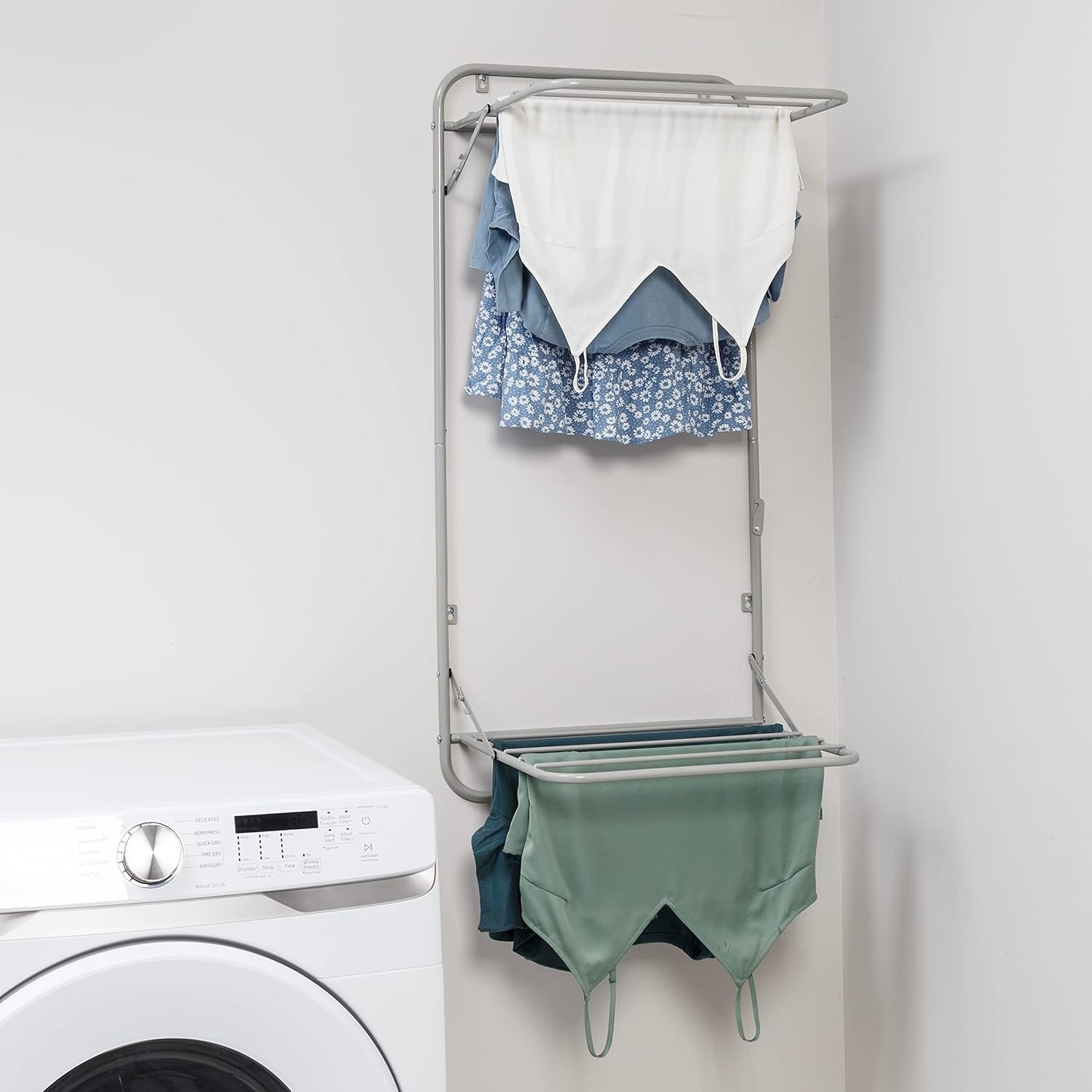
This over-the-door drying rack is a great option if you’re short on floor space but still want a dedicated area to air dry clothes. It hangs securely over any standard door and folds out into multiple rungs where you can dry shirts, undergarments, baby clothes, or even lightweight towels.
The smart design means you don’t have to commit to keeping it out all the time — once you’re done drying, you can fold it back flat against the door so it’s completely out of the way. That’s especially helpful in small apartments, dorm rooms, or shared spaces where every square foot matters.
Despite its compact size, it holds a surprising amount of laundry. Because the bars are spaced out, you also get decent airflow between garments, which speeds up drying time and prevents that damp, musty smell that can happen when clothes are too close together.
It’s not built for heavy items like large towels or jeans, but for everyday clothing, it’s an incredibly practical solution that keeps your space tidy.
Amazon Basics Foldable Clothes Drying Rack
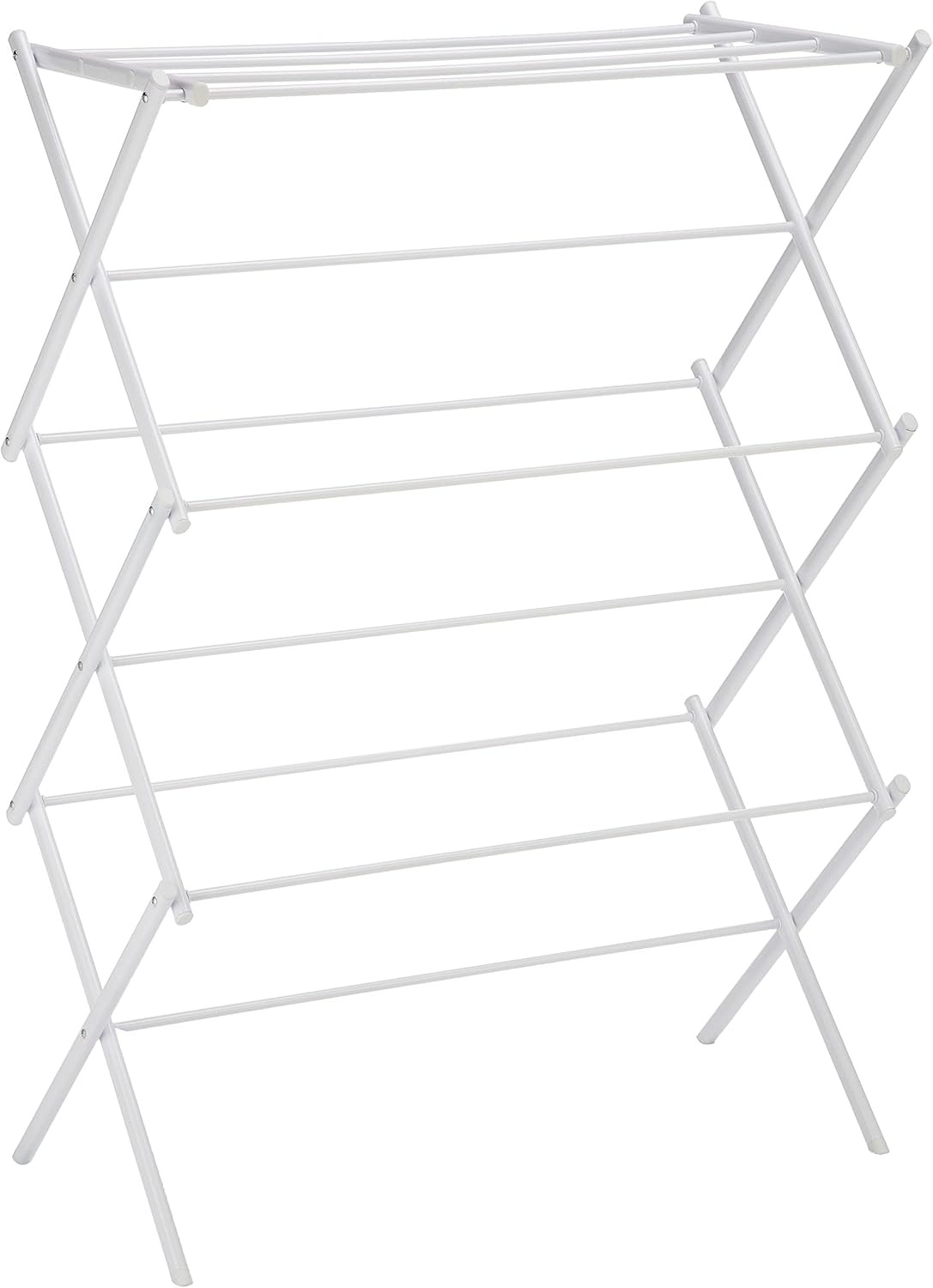
If you prefer something freestanding that can hold more items at once, this foldable drying rack is a reliable go-to. It opens up into a tiered A-frame design, providing plenty of space to spread out your laundry across multiple rungs. When not in use, it folds completely flat, so you can slide it behind a door, under the bed, or into a closet.
The coated steel frame is rust-resistant and light enough to move around easily, yet sturdy enough to hold heavier items like jeans, sweaters, or full-size towels. Its design allows for good airflow across all levels, which helps clothes dry faster and evenly — especially helpful for thicker fabrics that tend to hold moisture longer.
One of the most underrated aspects of this rack is its balance of capacity and portability. You can dry an entire load in one go without turning your home into a laundry jungle. And because it doesn’t require installation or wall hooks, it works well for renters or anyone who changes living spaces frequently.
Extra Hacks to Keep Things Running Smoothly
Even with good sorting, smart washing habits, and a solid folding and drying setup, laundry can still feel like it takes over your week — especially when the little things start getting in the way. Maybe you ran out of detergent mid-load, lost track of what’s clean and what’s not, or found yet another mystery stain after something was washed and dried. These aren’t major disasters, but they add friction — and over time, that friction turns laundry into a dreaded task.
This is where small, low-effort tweaks can make a surprisingly big impact. The goal is to reduce the number of decisions you have to make, streamline repetitive steps, and keep everything you need close at hand. When laundry supplies are scattered across shelves, shoved under the sink, or stored in different rooms, it creates more steps than necessary. Every extra step is a point where things can get delayed or forgotten.
One of the easiest fixes is creating a dedicated laundry station, even if you don’t have a full laundry room. It could be a corner with a rolling cart, a shelf above the washer, or a cabinet that holds your essentials: detergent, stain remover, mesh bags, dryer balls, color catchers, and anything else you use regularly. Keeping these items visible and accessible means you won’t waste time searching every time you need something.
Stain treatment is another area that often slows people down. You notice the stain… but forget to treat it until it’s too late. Having a spot-treatment spray or stick nearby lets you deal with it immediately, even before laundry day. Keep it in the hamper area, not just by the washer — that way you can handle stains the moment you take off the garment.
Another overlooked hack: keep a “stray item basket” in your laundry area. Socks without partners, random buttons, coins, hair ties — these things always show up. Instead of letting them float around or disappear, toss them into a small bin or pouch. Once a week, take two minutes to sort through it. This one habit saves time and keeps the laundry area from turning into a junk zone.
And if you live with others? Make laundry ownership clear. Whether it’s assigning baskets, having labeled sorter bags, or designating who does what on which day, a bit of structure avoids last-minute scrambling or arguments over who left wet clothes in the washer.
The truth is, laundry never stops — but it doesn’t have to feel endless. By building in small systems that reduce mess, avoid bottlenecks, and cut down on repeat effort, you make the process flow more naturally. You stop reacting to laundry problems and start quietly staying ahead of them.
A few smart habits and a couple of thoughtful tools can turn your laundry routine into something that actually works — not just something you deal with when it becomes urgent.
FAQ: Common Laundry Questions
How often should I wash different types of clothes?
That depends on the item and how heavily it’s used. Underwear, socks, and workout clothes should be washed after every wear. Shirts and blouses typically last 1–2 wears before needing a wash, while jeans and sweaters can often go 3–5 wears if they’re not visibly dirty. Towels usually need washing after 3–4 uses, and bedsheets once a week is a good standard. That said, if something smells or feels off, go ahead and wash it.
Are mesh laundry bags really necessary?
If you care about your clothes lasting longer — yes. Mesh bags protect delicate fabrics, keep small items from disappearing, and prevent tangling during the spin cycle. They’re especially helpful for lingerie, activewear, socks, and anything with straps or hooks that could catch on other items. They also make sorting after the wash easier since everything’s already grouped.
Why do my clothes still smell after washing?
There are a few reasons. You might be overloading the machine, which prevents proper rinsing. You might be using too much detergent (it builds up in fabric and traps odors). Or your washing machine might need a clean itself — mold and residue build up over time. Try running a hot cycle with white vinegar and baking soda to clean the drum, and make sure you’re drying clothes fully afterward.
What can I do about missing socks?
Sock loss is one of the most common — and annoying — laundry mysteries. The best solution is to contain them: put them in a mesh laundry bag, wash them in pairs, or use sock clips to keep them together. Also, check inside larger garments like pant legs or fitted sheets before emptying the washer. And keep a small “missing sock” bin so you have a place to check and re-match later.
How do I prevent color bleeding?
Always separate lights and darks — especially for new clothes that haven’t been washed before. Wash dark items in cold water, which helps reduce dye transfer. If you’re really worried, try using a color catcher sheet (they’re designed to absorb excess dye during the cycle). Avoid warm or hot water for mixed loads unless you’re sure everything is colorfast.
Can I air-dry everything instead of using a dryer?
Technically, yes — and for many items, it’s better. Air drying preserves fabric quality, prevents shrinkage, and saves energy. Just make sure you’re giving clothes enough space and airflow to dry properly, especially in humid environments. Some heavy items like thick towels or jeans might take longer to dry and may benefit from partial tumble drying to speed things up.
What’s the best way to handle laundry in a small apartment?
Use vertical space — hanging racks over doors, collapsible drying racks, and slim rolling carts for supplies. Pre-sorting helps too; even a small three-bin system can save you time and hassle. And consider compact tools like folding boards or laundry bags that stash away easily when not in use. The less clutter you create, the less stressful laundry day feels.
Is it okay to leave wet laundry in the washer for a while?
It’s okay for an hour or two, but beyond that, you risk mildew and odor setting in — especially in warmer weather. If you forget and things smell musty, rewash with a bit of baking soda or vinegar. Set a timer or phone reminder when you start a load to help build a habit of switching loads promptly.
Conclusion: Laundry Doesn’t Have to Wear You Out
Laundry isn’t going anywhere — but the stress that comes with it? That can absolutely be reduced. Most of what makes laundry feel overwhelming isn’t the washing itself. It’s the small, repeated frustrations: missing socks, cluttered spaces, wrinkled clothes you forgot to fold, delicates ruined in a single spin.
But with just a few simple shifts in how you approach the process — and a handful of tools that actually solve everyday problems — laundry becomes something manageable. Even, occasionally, satisfying.
A pre-sorting system removes the mental load of figuring out what to wash. Wash bags protect your favorite pieces and keep small items from vanishing. Folding boards turn a messy pile into a clean stack in seconds. Drying racks let you air dry without turning your home into a laundry jungle. And little habits, like keeping supplies within reach or treating stains immediately, help the entire routine run more smoothly.
You don’t need to do a full laundry overhaul or buy expensive equipment. You just need a setup that supports how you live — whether that’s fitting a drying rack behind your door, using a slim hamper to sort as you go, or setting up a simple shelf for detergent and bags.
Laundry won’t ever be the highlight of your week. But it also doesn’t have to be the thing you put off until it’s a mountain of chaos. With the right setup and a few reliable tools, it becomes another thing you handle with less stress, less effort, and way more ease.
